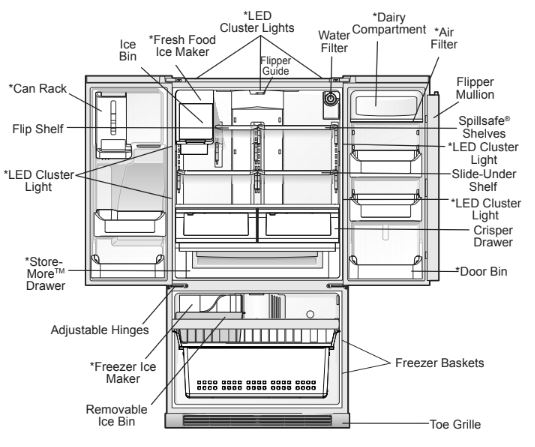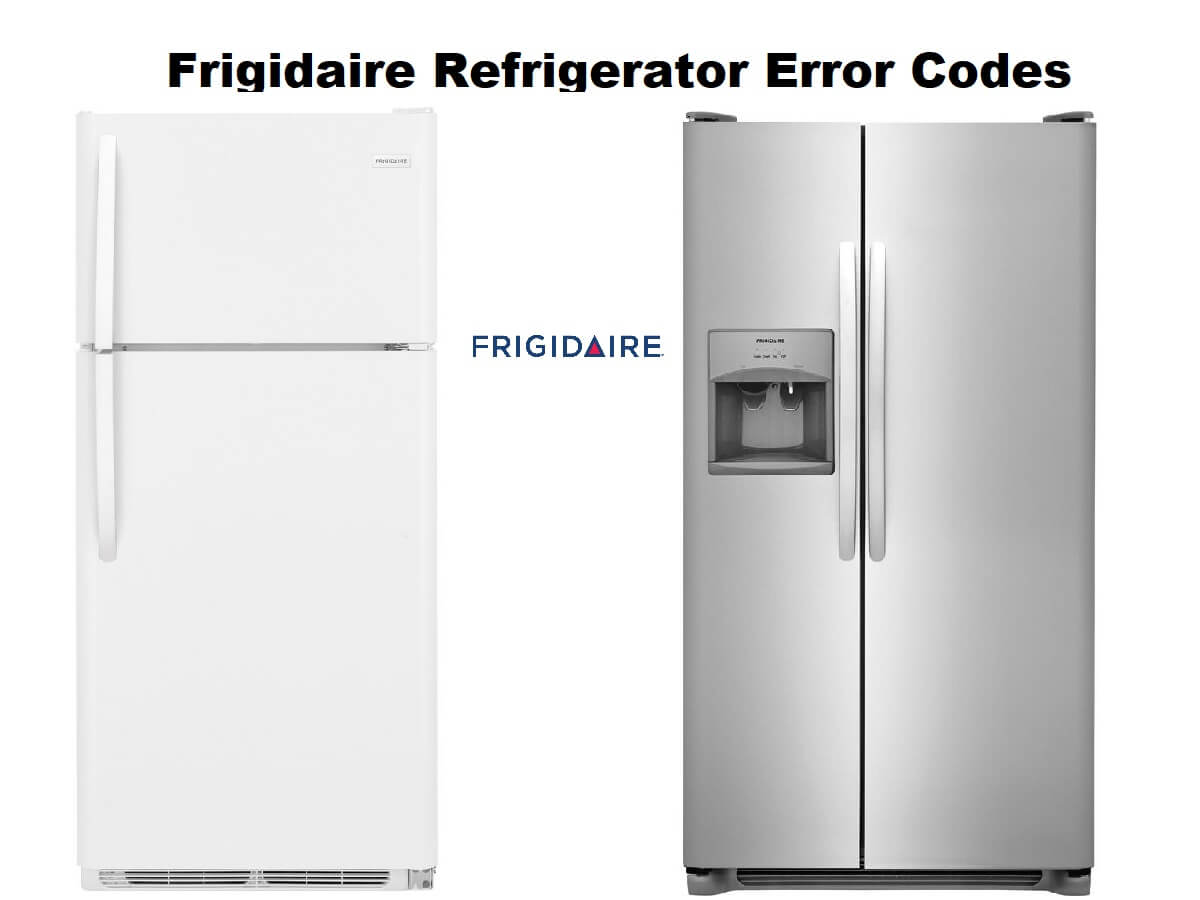Frigidaire Appliance Corporation is an American commercial and consumer home appliance brand. A subsidiary of Electrolux, it comes under the umbrella of a multinational company that holds offices and retail shops in different parts of the world. Offering customers all around the world a taste of some of the best choices available in the market. While the products are designed keeping the American lifestyle in mind, they offer great use in general.
Founded in 1918 by Guardian Frigidaire the company still has its head office in Fort Wayne Indiana. The company was the first in the market to develop a self-contained refrigerator back in 1918. Since then the company has offered a wide range of commercial and residential choices gaining the confidence of other companies in the market.
Frigidaire refrigerators might be a high-ranking company, but from time to time customers have complained about system errors. Fortunately, most of these errors can be fixed on your own. So rather than ignoring the error codes, your appliance is showing its time to note down the Frigidaire refrigerator error code and get to the bottom of the problem. To help you out we have listed down the most common error codes of Frigidaire refrigerators.
Codes List
| Error Codes | Interpretation |
|---|---|
| -- / OP | Open FF Cavity Thermistor |
| OP / -- | Open FZ Cavity Thermistor |
| -- / SH | Shorted FF Cavity Thermistor |
| SH / -- | Shorted FZ Cavity Thermistor |
| SY / CF | UI to Main Board communication failure; on start up |
| SY / CE | UI to Main Board communication error; after a period in operation |
| SY / EF | Freezer Evaporator Fan Failure |
| dl / SP | Ice Chute Door is open; check for obstruction |
| d / F | Manual Defrost |
| 77 / 77 | Demo / Showroom |
| Sb / Sb | Sabbath |
| FZ Temp / FF Temp | Current Air Temps |
| Numerical display of first test | FFIM Diagnostic |
| No FF or FZ display, all UI LEDs on | System Diagnostic |
| 52C | Ice Maker Thermistor |
| 55C | Water Valve |
| 57C | Evaporator Fan (FFIM) |
| 58C | Ice Level Sensor |
| 63C | Twist Tray |
| IC | Max Fill Time |
Parts Meaning

Troubleshooting
Problem: Ice maker is not making any ice.
Cause:
- Ice maker is turned off.
- Refrigerator is not connected to water line or water valve is not open.
- The water supply line is kinked.
- The water filter is not seated properly.
- The water filter may be clogged with foreign material.
- Freezer ice maker wire signal arm is being held up by an item not allowing it to go in the on or down position.
Solution:
- Turn on ice maker. For the fresh food ice maker, press and hold the “Ice Off” button for three seconds until the indicator light is off. For the freezer ice maker, lower the wire signal arm.
- Connect the unit to the household water supply and ensure the water valve is open.
- Ensure that the supply line does not kink when the refrigerator is pushed into place against the wall.
- Remove and re-install the water filter. Be sure to push the filter firmly so that you hear it lock solidly into position.
- If water dispenses slowly or not at all, or if the filter is six months old or older, it should be replaced.
- Move any item or frozen ice cubes that may block the signal arm from being in the on or down position.
Problem: Ice maker is not making enough ice.
Cause:
- Ice maker is producing less ice than you expect.
- The water filter may be clogged with foreign material.
- The water supply line is kinked.
- Saddle valve on cold water pipe is clogged or restricted by foreign material.
- Heavy traffic, opening or closing of the doors excessively.
- Freezer control is set too warm (freezer ice maker).
- Water pressure is extremely low. Cut-off and cut-on pressures are too low (well systems only).
- Reverse osmosis system is in regenerative phase.
Solution:
- The fresh food and freezer ice makers will each produce approximately 2.5 pounds of ice every 24 hours depending on usage conditions.
- If water dispenses slower than normal, or if the filter is six months old or older, it should be replaced.
- Ensure that the supply line does not kink when the refrigerator is pushed into place against the wall.
- Turn off household water line valve. Remove valve. Ensure that valve is not a self-piercing saddle valve. Clean valve. Replace valve if necessary.
- Press Fast Freeze to temporarily increase ice production rate. (Freezer ice maker only.)
- Set freezer control to colder setting to improve performance of the ice maker (freezer ice maker). Allow 24 hours for temperature to stabilize.
- Have someone turn up the cut-off and cuton pressure on the water pump system (well systems only).
- It is normal for a reverse osmosis system to be below 20 psi during the regenerative phase.
Problem: Ice cubes are freezing together.
Cause:
- Ice cubes are not being used frequently enough or interruption of power for prolonged time.
- Ice cubes are hollow (shells of ice with water inside). The hollow cubes break open in the bin and leak their water onto existing ice, which causes it to freeze together.
Solution:
- Remove ice container and discard ice. The ice maker will produce fresh supply. Ice should be used at least twice weekly to keep the cubes separated.
- This generally occurs when the ice maker does not get enough water. This is usually the result of a clogged water filter or restricted water supply. Replace the water filter and if the condition still occurs check for a Saddle Valve, water valve not turned on all the way or kinked water supply line.
Problem: Dispenser will not dispense ice.
Cause:
- Dispenser lock out is engaged.
- There is no ice in the bin to be dispensed.
- The refrigerator doors are not completely closed.
- Dispenser paddle has been pressed too long and the dispenser motor has overheated.
Solution:
- Press and hold control lock for three seconds.
- See the “Ice maker is not making any ice” section above.
- Be sure the refrigerator doors are completely closed.
- The motor overload protector will reset in about three minutes and then ice can be dispensed.
Problem: Ice dispenser is jammed.
Cause:
- Ice has melted and frozen around auger due to infrequent use, temperature fluctuations, and/or power outages.
- Ice cubes are jammed between ice maker and back of ice container
Solution:
- Remove ice container, thaw, and empty the contents. Clean container, wipe dry, and replace in proper position. When new ice is made, dispenser should operate.
- Remove ice cubes that are jamming the dispenser.
Problem: Dispenser will not dispense water.
Cause:
- Dispenser lock out is engaged.
- Water filter not seated properly.
- Water filter is clogged.
- Household water line valve is not open.
Solution:
- Press and hold control lock for three seconds.
- Remove and reinstall the water filter. Be sure to push the filter firmly so that you hear it lock solidly into position.
- Replace filter cartridge. Be sure to remove protective caps and push the filter firmly so that you hear it lock solidly into position.
- Open household water line valve.
Problem: Water has an odd taste and/or odor.
Cause:
- Water has not been dispensed for an extended period of time.
- Unit not properly connected to cold water line.
Solution:
- Draw and discard 10-12 glasses of water to freshen the supply.
- Connect unit to cold water line that supplies water to the kitchen faucet.
Problem: Door(s) will not close.
Cause:
- Door was closed too hard, causing other door to open slightly.
- Refrigerator is not level. It rocks on the floor when moved slightly.
- Refrigerator is touching a wall or cabinet.
Solution:
- Close both doors gently.
- Ensure floor is level and solid, and can adequately support the refrigerator. Contact a carpenter to correct a sagging or sloping floor.
- Ensure floor is level and solid, and can adequately support the refrigerator. Contact a carpenter to correct a sagging or sloping floor.
Problem: Compressor does not run.
Cause:
- Freezer control is set to “OF” or “0”
- Refrigerator is in defrost cycle.
- Plug at electrical outlet is disconnected.
- House fuse blown or tripped circuit breaker.
- Power outage.
Solution:
- Set freezer control.
- This is normal for a fully automatic defrost refrigerator. The defrost cycle occurs periodically, lasting about 30 minutes.
- Ensure plug is tightly pushed into outlet.
- Check/replace fuse with a 15 amp time-delay fuse. Reset circuit breaker.
- Check house lights. Call local electric company.
Problem: Refrigerator runs too much or too long.
Cause:
- Room or outside weather is hot.
- Doors are opened too frequently or too long.
- Fresh Food/freezer door may be slightly open.
- Freezer control is set too cold.
- Fresh Food/freezer gasket is dirty, worn, cracked, or poorly fitted.
- Condenser is dirty.
Solution:
- It’s normal for the refrigerator to work longer under these conditions.
- Warm air entering the refrigerator causes it to run more. Open doors less often.
- Ensure refrigerator is level. Keep food and contains from blocking door.
- Set Fresh Food control to warmer setting until refrigerator temperature is satisfactory. Allow 24 hours for temperature to stabilize.
- Clean or change gasket. Leaks in door seal will cause refrigerator to run longer in order to maintain desired temperatures.
- Clean condenser.

